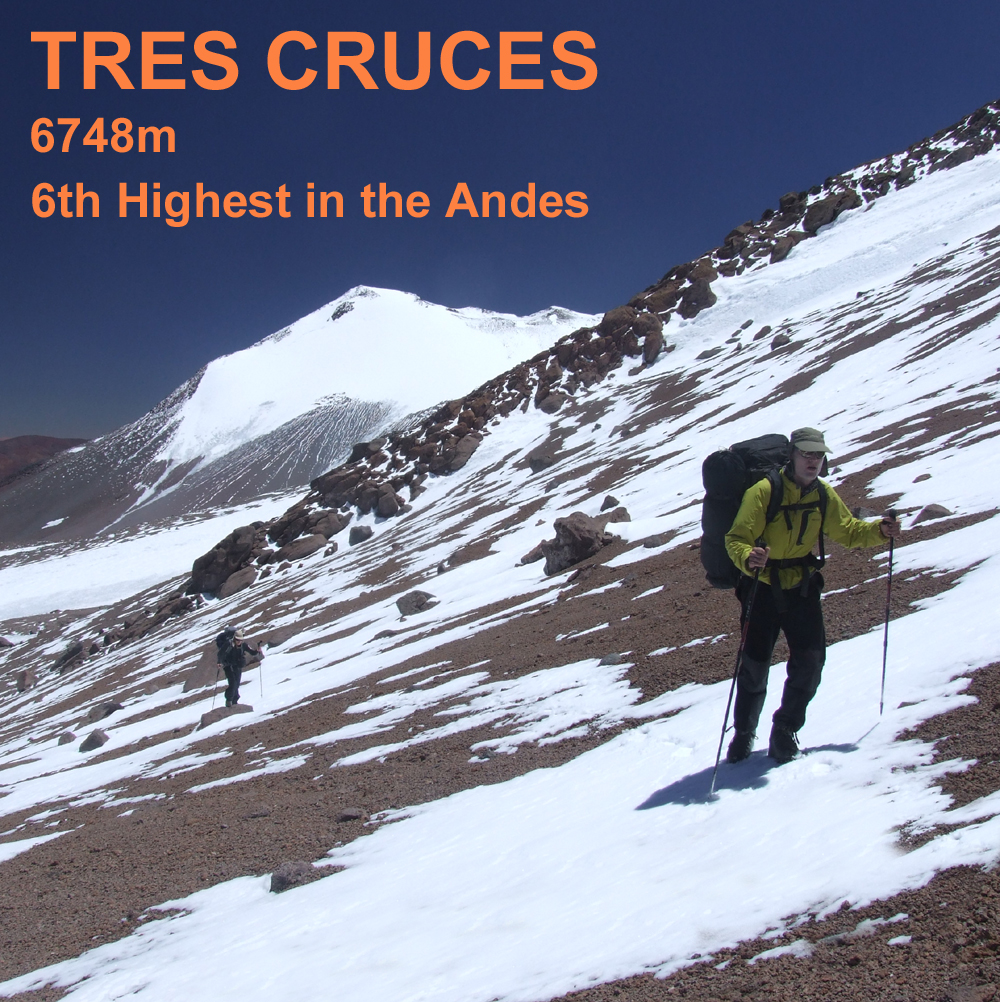 |
Dates | November to January |
| Duration | 20-24 days | |
| Grade | 2C | |
|
"Andes" Leadership Fee
(includes leaders expenses) about £2500 |
||
High Altitude Ascents in Northern Chile.
This expedition is not currently scheduled, but we coudl run a private trip, or another edition with sufficient demand.
PRICES & COSTS
All are per person.
"Andes" Leadership Fee (includes leaders expenses) -- about £2500
Estimated Airfares -- £1200
Estimated Travel Costs in Chile -- £700
Estimated Accommodation & Meals -- £300
ESTIMATED TOTAL COST per person -- £4700
What's included in the price you pay ANDES and what's not.
INTRODUCTION
This expedition will be based in the Puna de Atacama area of northern Chile, a part of the Andes we know very well. We've run many successful trips here in the past twenty five years, including six previous trips to the peaks around the Laguna Verde in Chile and four previous trips to the Tres Cruces massif itself.
The expedition will fly out to the provincial city of Copiapo via Santiago, the capital city of Chile. We'll have an initial acclimatisation phase of four days of camping and walking at about 3000-4000m around Vallecitos and the Laguna Negro Francisco. During these days we'll climb to 4500m or even 5000m on some easy foothills, with great views to the Tres Cruces and Tres Quebradas massifs.
After the acclimatisation phase we'll head for our first big peak, Tres Quebradas 6239m. This peak lies just south of Tres Cruces on the border with Argentina. Using a 4x4 we can drive to about 4500m on the northwest side of the mountain. From here we'll make a backpacking day to reach a high camp at around 5000-5200m, then climb to the summit the next day, going either over or around the west peak.
Our second peak will most likely be Barrancas Blancas 6119m. This mountain lies about 30km to the north of Tres Quebradas near the Laguna Verde. We'll have a brief stay in a Copiapo hotel to rest, shower and re-supply before heading there. We'll climb Barrancas Blancas in a single day from a camp at the "roadhead" at about 4900m. We may substitute a similar 6000m peak, such as El Ermitaño or Peña Blanca if conditions dictate.
Finally we'll head to the Tres Cruces massif. These mountains are pictured below seen from the Laguna Santa Rosa to the west. The photo was taken in very dry conditions with very little snow. We have six days here and our main objective will be to climb the highest of the three peaks, Tres Cruces Sur 6748m. We'll start from a vehicle base camp at 5100m, climbing in 1 or 1½ days to a high camp at 5950m in the col between the central and southern peaks. The approach to this camp is pictured above on the title photo. From the high camp Tres Cruces Sur is a relatively short day (just 800m ascent) but over some very rough ground higher up. It is likely that we'll have time whilst on the mountain to climb at least one of the other peaks, either Central 6629m or Norte 6030m. Central is climbed from the same high camp as the Sur peak, in just 4 or 5 hours. Norte can be climbed in a day from where we park the 4x4 vehicle.
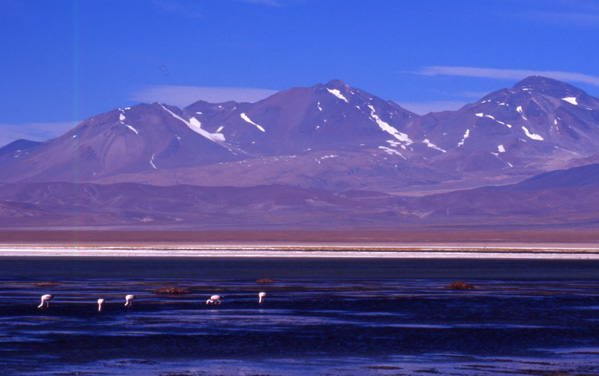
All of the peaks listed on this itinerary have no technical climbing on them and are just "walks". But these "walks" can be over very rough and unstable ground, and it is all at extreme altitude. So although all the ascents on this expedition are suitable for strong hillwalkers, some previous expedition experience is preferred due to the demanding walking, weather and camping conditions.
We do not expect to use an ice-axe and crampons for the peaks on the main itinerary, however it is necessary to have these with you in Chile in case of unusually snowy conditions. Previous experience of their use is not necessary. Please call or email if you have any questions about the suitability of this trip for you.
Outline Itinerary |
|
| Days 1-2 | Flights to Santiago and Copiapo |
| Day 3 | Preparation in Copiapo and depart for first camp |
| Days 4-7 | Acclimatisation walks from camps at 3000m and 4000m |
| Days 8-11 | Ascent of Tres Quebradas 6239m. |
| Day 12 | Full days rest in Copiapo. |
| Days 13-15 | Ascent of Barrancas Blancas, 6119m. |
| Days 16-21 | Ascent of Tres Cruces Sur, 6748m (and possibly Central and/or Norte). |
| Days 22-23 | Fly home via Santiago |
General Information about our holidays
Please read our warning on altitude before booking this expedition to high altitudes.
Who runs 'Andes' and where we are based
General information about equipment, accommodation, flights, meals etc.
THE PUNA DE ATACAMA
The plateau of the Puna de Atacama lies on the border between Chile and Argentina and includes a huge area over 4000m above sea level. There are over thirty major 6000m summits in the immediate area, and probably still unclimbed peaks of over 5000m in this remote area. The Puna is one of the most beautiful and haunting places in the Andes, compared by many to the high plateau of Tibet. The scenery is a bit desolate for some, but the huge open spaces, clear air and big blue skies leave a deep impression on everyone who visits this area.
COPIAPO
Copiapo is a small provincial capital in the Atacama desert at the foot of the Andes, about 500m above sea level. It is the nearest access city with an airport for the Chilean side of the Puna de Atacama. Copiapo is a major mining centre in northern Chile, so we'll apologise in advance for there not being a great deal of touristic stuff to see around town but at least you'll get a good steak and a hot shower! The hotel we normally use also has nice relaxing grounds and a swimming pool.

Tres Quebradas from the Northwest. Our route will be around the left side of the small (5950m!) forepeak, then up the ridge behind.
WILDLIFE
Despite the fact that at first sight the high plateau of the Puna de Atacama is very barren, the area is really quite good for seeing some of South Americas unusual wildlife, particularly on the acclimatisation phase and on the 4x4 drives into and out of the mountains. Vicuña and guanaco are wild relatives of the llama and are seen frequently in the foothills. On the lagoons there are flamingos, giant coots and other species of birds and on this trip we can pretty much guarantee to see a condor circling the peaks.
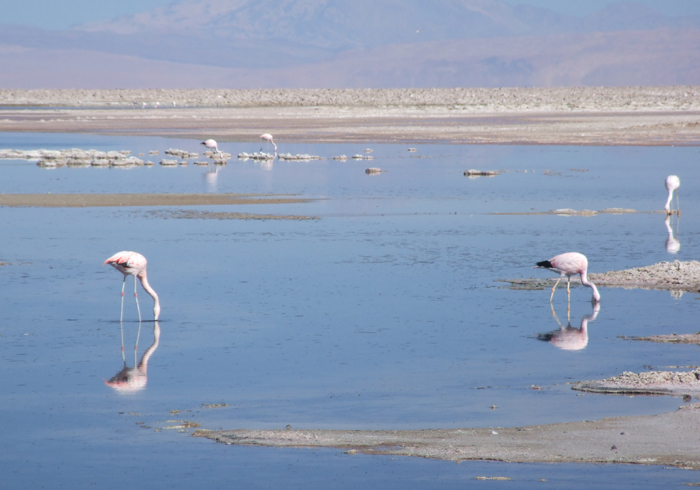
Flamingoes in the Atacama near our acclimatisation base.
FITNESS & EXPERIENCE NEEDED
Although there is no difficult climbing involved in the ascents planned on this expedition, climbing to such heights is still a serious matter because of the low air pressure at high altitude. We will allow time for expedition members to acclimatise to the altitude but because of the nature of the expedition we recommend clients to have previous successful experience at altitudes of about 5000m or higher.
For this expedition good mountain fitness and stamina are important, but for high altitude expeditions clients also need good cardiopulmonary (heart and lung) fitness. This can only be maintained, by a program of intensive exercise such as sprinting (not jogging), squash or sprint cycling. This should be done in small doses (e.g. half an hour every other day) over a period of at least two months.
Clients should be prepared for cold nights camping and be prepared for very windy and dusty weather at times out in the mountains. As we'll be a long way from the nearest supermarket we will have to put up with some tinned and freeze-dried food in our diet during our time in the mountains. All clients are expected to help with the routine work of this type of expedition; pitching tents, cooking and washing up
CLIMATE
The climate at altitude in the Puna de Atacama is very cold and extremely dry. In the mountains temperatures can fall to -20ºC at night. During the day in the mountains it can feel very warm in the strong sun, but it can also be bitterly cold and windy. It should be dry all the time we are in South America, although there is a chance of a snow flurry, or occasional afternoon thunderstorm in the mountains. As we are near the tropics come prepared for about 10 hours of darkness every night. Temperatures in the valleys around Copiapo and in other low lying areas will be a very pleasant 20-25ºC during the day.
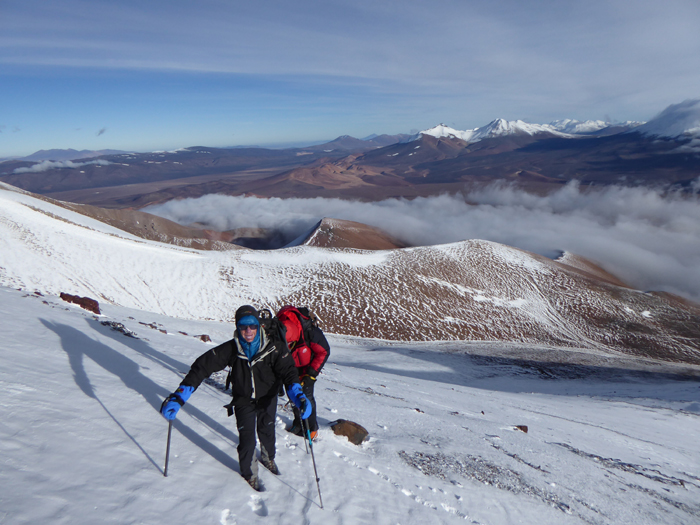
Nearing the summit of Barrancas Blancas during a snowy ascent, January 2019.
ORGANISATION & LEADERSHIP
Our expeditions are designed to be small and flexible. The expedition will be co-ordinated, organised and lead by us, but we will consult and involve the expedition members when planning the day-to-day details of the trip. Please note however that the leaders decision is final where the safety of the group or any member is in jeopardy; for example where retreat or diversion is necessary due to illness or bad weather. The minimum number of customers we need to run this expedition is three. The maximum size of the expedition will be four customers plus leader.

Dinner at 4300m, Chilean Puna de Atacama expedition, January 2017.
INSURANCE, HEALTH & SECURITY
All clients must be insured for medical costs and repatriation in an emergency. We recommend having insurance for baggage, personal liability and cancellation as well. If you would like further advice please ask. Chile is a well developed country. Vaccinations for tetanus, typhoid and polio are recommended. The country is very safe and relaxing to travel in; theft and muggings are no more likely than they are in most of Britain or Europe.
WHAT'S INCLUDED IN OUR PRICE AND WHAT'S NOT INCLUDED
Our price is for leadership/guiding and mountain services only. It INCLUDES the leaders fee (wages) and all their expenses, such as flights, travel, hotels, meals, permits. It also INCLUDES his or her share of communal expenses, which may be such things as 4x4 rentals, diesel and fuel, mule and porter costs, shared hotel rooms.
Our price also INCLUDES all mountain services such as provision of tents, stoves and all other communal camping equipment, all mountain food including all camp food and lunches on day trips. It also INCLUDES any communal mountaineering equipment that may be necessary, and on most expeditions emergency use of a satellite telephone link.
Our price does NOT INCLUDE - your flights, your insurance, your hotel/hostel accommodation, your meals taken at cafes and restaurants, your share of communal travel costs (e.g 4x4 rental, mule costs), your personal climbing and camping equipment (i.e. used by you alone, such as sleeping bag, ice-axe, crampons), permits or peak fees payable by yourself.
SAFETY AND RISK
This is an adventure holiday and all
clients will be exposed to hazards not found in
everyday life by taking part in this itinerary. While we take all
reasonable precautions to reduce risk it is neither possible nor desirable
to completely eliminate these hazards. It is important that you understand
the hazards you may be exposed to before
signing our booking form. We have identified the following areas as the
principal additional risks of this itinerary. (Some of
these could potentially result in serious injury or death). This is
not a fully inclusive list - a more
detailed risk assessment of this itinerary is available on our
Risk Assessments page, or phone/e-mail us
and ask some questions!
Driving, hotels and general
safety : In Chile the driving, fire standards and general safety standards are
not quite as high as in Europe, although they are now very good
Extreme remoteness : You will be
camping in a remote area for an extended period and therefore obtaining
medical assistance for any problem will be a slow process.
There is no chance of a helicopter rescue.
Minor slips and falls : due to
steep, uneven and unstable ground.
Weather : The Puna de Atacama is
occasionally affected by severe and sometimes dangerous storms, including
thunderstorms. There are frequent high
winds. Forecasts are
not so reliable.
Altitude : At high altitudes there is an increased risk of
medical problems, most obviously altitude illness.
Mountain Hazards : In certain places you may be subjected to a slight risk
of rock fall.
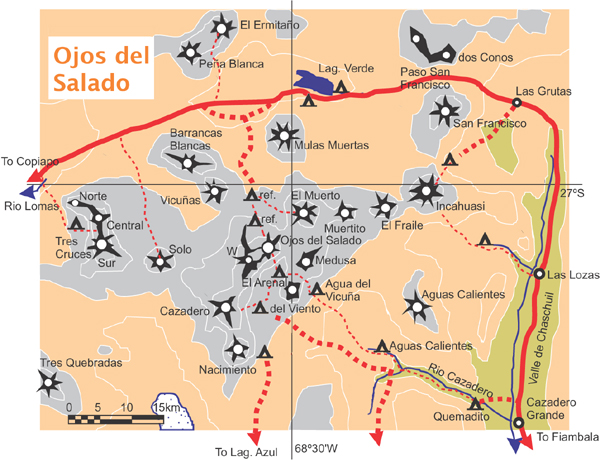
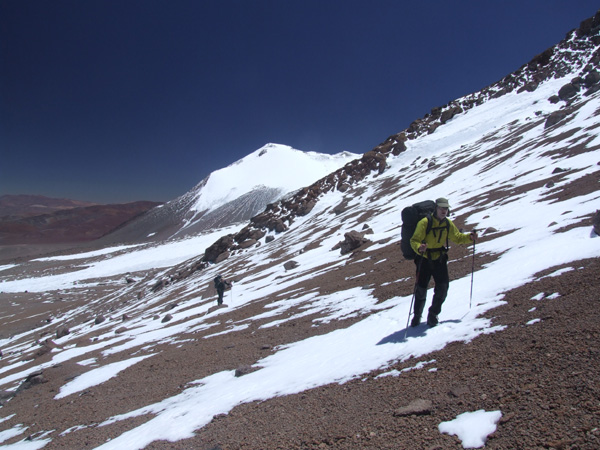
Climbing up to the high camp on Tres Cruces at about 5600m. The peak in the background is Tres Cruces Norte.

